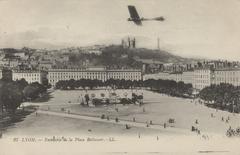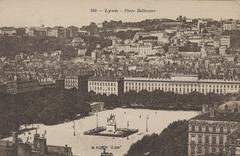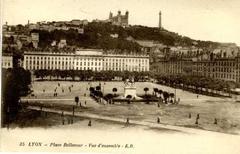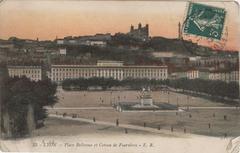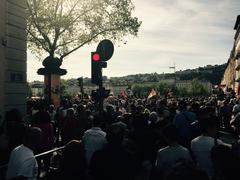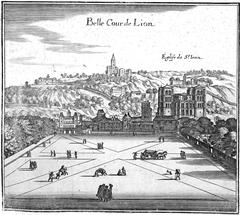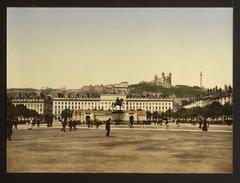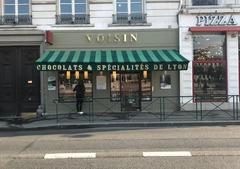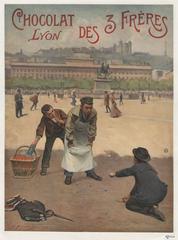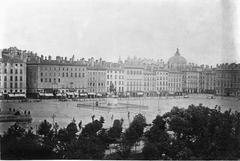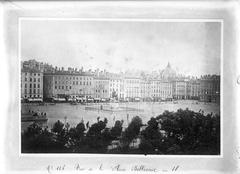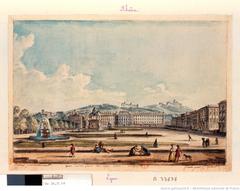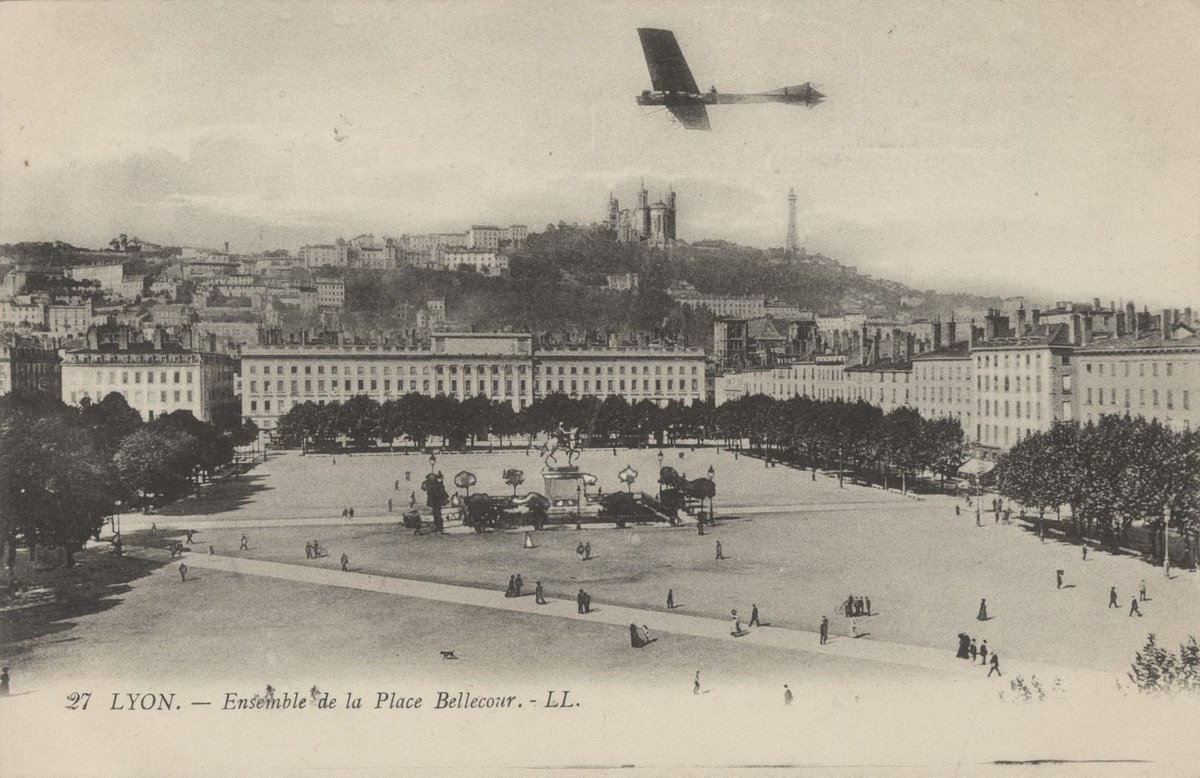
Place Bellecour Visiting Hours, Tickets, and Attractions in Lyon, France
Date: 14/06/2025
Introduction
Place Bellecour is the vibrant heart of Lyon, France, and one of Europe’s largest pedestrian squares. Spanning over 62,000 square meters, it stands as a monumental testament to the city’s historical, architectural, and cultural evolution. From its origins as a Gallo-Roman trading hub to its transformation under royal reign and its status today as a UNESCO World Heritage site, Place Bellecour offers a unique blend of history and modern urban life. Notable for the iconic equestrian statue of Louis XIV, elegant neoclassical facades, and a dynamic calendar of events—including the innovative 2025 “Tissage Urbain” installation—Place Bellecour is an essential destination for any visitor to Lyon.
This comprehensive guide details the square’s history, architectural features, practical information on visiting hours and accessibility, special events, and nearby attractions, ensuring an unforgettable experience for both travelers and history enthusiasts. For up-to-date information and resources, consult the Lyon Tourist Office and official tourism websites (This is Lyon, The Tour Guy, Petit Paumé).
Table of Contents
- Historical Evolution of Place Bellecour
- Architectural Significance
- Visiting Place Bellecour: Practical Information
- Special Events and “Tissage Urbain”
- Nearby Attractions
- Frequently Asked Questions (FAQs)
- Conclusion
- References
Historical Evolution of Place Bellecour
Gallo-Roman Origins and Medieval Development
The site of Place Bellecour has been central to Lyon’s urban fabric since the Gallo-Roman period. Located on an alluvial island between the Rhône and Saône rivers, it served as a bustling center for military and commercial activities. Archaeological findings indicate the presence of Roman traders and boatmen, setting the foundation for centuries of urban growth (This is Lyon).
By the 12th century, the area became ecclesiastical property and was known as “Bella curtis”—Latin for “beautiful garden.” After a period as a vineyard, the land fell into neglect and became swampy, only to gain prominence again during the 16th-century Wars of Religion when it was used as a military encampment.
Royal Transformation and Urban Planning
The transformation of Bellecour into a grand civic space began in the early 17th century, when King Henry IV ordered the city to acquire the land for public use. Implementation was delayed by legal disputes until the 18th century, when Louis XIV’s urban vision took shape. The square’s layout and monumental equestrian statue of Louis XIV, originally erected in 1713 and replaced by François-Frédéric Lemot’s version in 1825 after the Revolution, solidified its status as a symbol of royal authority and urban grandeur.
Modern Era and UNESCO Recognition
Throughout the 19th and 20th centuries, Place Bellecour became Lyon’s social and civic nucleus—hosting public demonstrations, festivals, and major events. In 1998, it was designated part of Lyon’s UNESCO World Heritage district, celebrated for its remarkable continuity and historical depth (This is Lyon).
Architectural Significance
Monumental Scale and Urban Design
Place Bellecour is one of Europe’s largest open squares, measuring 312 by 200 meters. Its vast, open expanse—characterized by distinctive red ochre gravel—creates a sense of grandeur and offers unobstructed views of Fourvière Hill and the city’s skyline (francerent.com).
Iconic Monuments
- Equestrian Statue of Louis XIV: The square’s centerpiece, sculpted by François-Frédéric Lemot in 1825, depicts the Sun King in Roman attire and is a popular meeting point (touristplatform.com).
- Saint-Exupéry and The Little Prince: In the southwest corner, a statue honors Lyon-born writer Antoine de Saint-Exupéry and his beloved character, installed in 2000.
Surrounding Architecture
Elegant 19th-century facades encircle the square, housing luxury boutiques, hotels, and the Lyon Tourist Office. The architectural harmony is underscored by symmetrical designs, wrought-iron balconies, and protected heritage status (touristplatform.com).
Visiting Place Bellecour: Practical Information
- Visiting Hours: Place Bellecour is a public square open 24 hours a day, year-round.
- Tickets: Entry is free. Some seasonal attractions (e.g., ice rink, Ferris wheel) require paid tickets.
- Tourist Office: Located on the square, open daily from 9:00 to 18:00 (closed December 25 and January 1). Provides maps, bookings for guided tours, and accessibility assistance.
- Accessibility: The square is fully wheelchair- and stroller-accessible, with flat surfaces and ramps.
- Transport: Served by Bellecour metro station (lines A and D) and numerous bus routes.
Travel Tips:
- Visit early in the morning or late afternoon for the best light and fewer crowds.
- Use public transport, as parking is limited, especially during events.
- Check Lyon Tourist Office or official tourism sites for event schedules and guided tour availability.
Special Events and “Tissage Urbain”
Place Bellecour is animated year-round by major events such as the Festival of Lights, Christmas markets, and public gatherings. In 2025, the square debuts “Tissage Urbain,” a participatory public art installation designed by Romain Froquet (Petit Paumé).
“Tissage Urbain” Installation (2025–2030)
- Concept: Five monumental wooden structures support nearly 1,500 square meters of locally woven fabric, forming shaded canopies.
- Purpose: Pays homage to Lyon’s silk-weaving heritage (the Canuts), while providing comfort by addressing the urban heat island effect.
- Sustainability: Constructed from certified wood and recyclable materials, with local artisans involved in production.
- Integration: The design is reversible and non-invasive, maintaining clear views of monuments and accommodating ongoing public events.
- Nighttime Ambiance: Subtle lighting highlights the installation after dark, enriching the square’s atmosphere (Mairie 2e Lyon).
Nearby Attractions
Place Bellecour’s central setting provides easy access to Lyon’s top sites:
- Vieux Lyon (Old Town): UNESCO-listed Renaissance district with traboules (hidden passageways).
- Fourvière Basilica: 19th-century basilica atop Fourvière Hill, accessible by funicular.
- Musée des Beaux-Arts: Housed in a former convent, this museum features art from antiquity to the present.
- Rue de la République: Bustling shopping street with boutiques and cafés.
- Presqu’île District: Elegant squares, restaurants, and vibrant nightlife.
Frequently Asked Questions (FAQs)
Q: What are the visiting hours for Place Bellecour?
A: The square is open 24/7. The Tourist Office operates 9:00–18:00 daily (except December 25 and January 1).
Q: Is there an entrance fee?
A: No, access to Place Bellecour is free. Some seasonal attractions may charge admission.
Q: How do I get to Place Bellecour?
A: Take metro lines A or D to Bellecour station, or use city buses.
Q: Is the square accessible for people with reduced mobility?
A: Yes, Place Bellecour is fully accessible, with smooth, flat surfaces and ramps.
Q: Are guided tours available?
A: Yes, walking tours that include Place Bellecour are available through the Lyon Tourist Office and authorized providers.
Q: What is the “Tissage Urbain” installation?
A: It is a major public artwork providing shade and honoring Lyon’s silk-weaving heritage, on display from 2025 for five years.
Conclusion
Place Bellecour is more than a city square—it’s a living monument to Lyon’s rich history, architectural splendor, and vibrant community life. From the iconic equestrian statue of Louis XIV to the innovative “Tissage Urbain” installation, the square seamlessly blends tradition and modernity, serving as a hub for cultural events, daily social life, and urban exploration.
With free entry, excellent public transport links, and proximity to major attractions, Place Bellecour is the ideal starting point for discovering Lyon. Make the most of your visit by consulting the Lyon Tourist Office, joining a guided tour, or simply relaxing in the square’s unique atmosphere.
Plan your visit today: Download the Audiala app for guided tours, insider tips, and real-time event updates. Follow us on social media for more travel inspiration and the latest news from Lyon.
References
- This is Lyon – Place Bellecour Overview
- The Tour Guy – Top Things to Do in Lyon
- Petit Paumé – “Tissage Urbain” Installation Details
- FranceRent – Place Bellecour Attractions
- TouristPlatform – Place Bellecour Guide
- Mairie 2e Lyon – “Tissage Urbain” Project
Images should include descriptive alt text such as “Place Bellecour visiting hours” and “Lyon historical sites” for optimal SEO.
